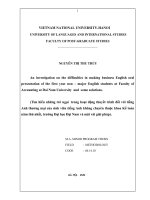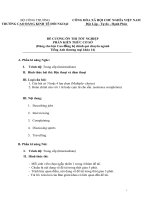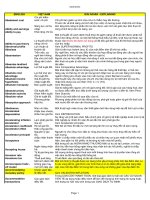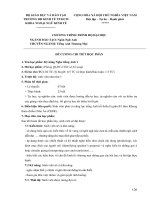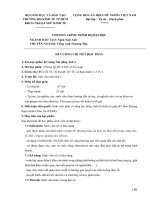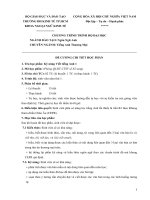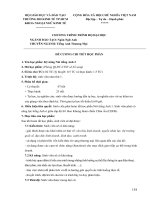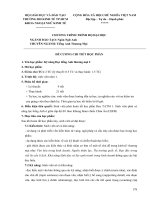Tiếng Anh Thương Mại 2.2 Topic Plain english report writing
Bạn đang xem bản rút gọn của tài liệu. Xem và tải ngay bản đầy đủ của tài liệu tại đây (109.31 KB, 10 trang )
z
BỘ GIÁO DỤC VÀ ĐÀO TẠO
TRƯỜNG ĐẠI HỌC THƯƠNG MẠI
REPORT
GROUP 5
Topic 4.5
Nguyễn Thị Thơm
Võ Thị Thơm
Nguyễn Thị Thu(TK)
Cao Đình Thư(NT)
Tạ Thị Bích Thủy
Trần Thị Thủy
Hà Thị Thu Trang
Mai Thị Trang
Mơn: Tiếng Anh thương mại 2.2
Lớp HP: 2084ENPR5311
Năm học 2020-2021
1
Đánh giá
STT
36
Họ và tên
Cao Đình Thư
33
40
37
Nguyễn Thị Thơm
Mai Thị Trang
Tạ Thị Bích Thủy
34
35
Võ Thị Thơm
Nguyễn Thị Thu
38
Trần Thị Thủy
39
Hà Thị Thu Trang
Nhiệm vụ
Nhóm trưởng – Tổng hợp powerpoint
Phần 1 – The definition and
advantages of plain english
Phần 2 – Give instructions
Phần 3.1 – Passives
Phần 3.2 – Actives
Phần 4 – Keep your sentences short
Phần 5 – Talk to your reader
Thư ký – Tổng hợp word
Phần 6 - Nominalisation
Phần 7 – Cutting out useless words
and other points to consider
Phần 8 – Using lists
2
Điểm
Topic 4.5: Plain english report writing
I. Definition of Plain English and its Benefits
- Give two different writing style paragraphs for demonstration.
Ex1: Son Tung MTP's latterly launched digitalized video music product has taken the
top spot in the video composite panel. Thereby, of course, it becomes one of the
leading videos watched by audience on Youtube in a number of many countries.
- This piece of writing contains long-winded, complex expressions and unnecessary
words
Hard to get the information
Ex2: Son Tung M-TP's latest MV has dominated several charts to become one of the
most trending YouTube videos in a host of countries.
- This one carries the same meaning but it is shorter, clearer, easier to understand.
Definition: Plain English is a way of presenting information that helps someone
understand it the first time they read or hear it.
Its advantages for writing:
- Save time for reading and understanding.
- Save money and personnel resources to inform or rewrite as it is friendly to readers.
II. Give instructions
Don't be afraid to give instructions
First of all, I have some examples:
- Go out!
- Open your book.
- Please give it to me.
These examples are all commands - officially called imperatives. They are the fastest
and most direct way of giving someone instructions. We often see the imperative form
in instruction manuals or when someone tells you how to do something.
However, if we asked a hardened bureaucrat to write these expressions, we would end
up with something like the following:
- Dogs are advised that they should stop barking.
- I should be grateful if you would give it to me.
Besides, there always seems to be a fear of commands. The most common fault is
3
putting 'students should do this' or 'you should do this' instead of just 'do this'. Perhaps
people worry that commands sound too harsh. But you can often solve this by putting
the word 'please' in front. However, if something must be done, it is best not to say
‘please’ as it gives the reader the option to refuse the request.
Here are some examples of long-winded phrases and shorter versions that use
commands:
- You should tell her the truth.
Tell her the truth.
- They should be drawn carefully.
Draw them carefully.
The last example is probably the worst because it uses a passive verb - 'should be
drawn'. Unfortunately, this is very common in instructions. For example:
- This car should not be parked here.
No parking.
III. Passives and Actives
Do you want to reports to sound active or passive – crisp and professional or stuff and
bureaucractic? In this part, we are going to consider the difference between active and
passive verbs in writing reports in plain English.
1. Passives
- Passive verbs make writing duller and harder to understand. With passive verbs, the
thing come first, then “tobe” ,” past participle, “by” and the doer come after that.
•
O+ tobe+ Ved/pp+ by+ S
Eg: The boss closed the door ( active)
The door was closed by the boss ( passive)
You can see that by making the passive sentence, we have had to introduce the word
“was” and “by” , which means the sentence is now much clumsier.
- Remember that the doer is not always a person and the thing is not always a thing!
Eg: The tree crushed Henry ( active)
Henry was crushed by the tree ( passive)
- Sometimes the doer gets left out. Sentences with passive verbs can make sense
without having a doer. For instance: “ the report is being written”, “ the cake was
eaten” all leave out the doer. People used to officialese often write reports that are full
of passive verbs, with sentences like these.
Eg:
+ 35 sites were visited in three weeks. Procedures were being properly followed at the
sites visited.
So in this example, the reader may be left asking : “ who visted the sites?” ,“ who was
following procedures properly?” and so on. Changing to active verbs reveals the
4
“doers” and sharpens up dull and unclear sentences.
+ We visited 35 sites in three week. At the sites we visited, we found that staff were
following procedures properly.
You will notice that in the last sentence we have used an active verb instead of “ an
awareness of”. As we shall see later this is an example of changing a “
nominalisation” into a verb.
- Spotting passives:
There is another way of spotting passive verbs which is especially useful when the
doer isn’t mentioned in the sentence.
- First, passive verbs almost always have one of the following words added on - be,
being, am, are, is, was, were, will be. They are all formed from the verb ‘to be’.
- Second, passive verbs have a ‘past participle’( Ex: ask- asked, write- written)
- Good uses of passives :
• To make something less hostile .
Example: “This bill has not been paid” (passive) is softer than “you have not
paid this bill” (active).
• To avoid taking the blame .
Example: “A mistake was made” (passive) rather than “we made a mistake”
(active).
• When you don’t know who or what the doer is .
Example: “The patient was advised to avoid alcohol”
• If it simply sounds better but aim to make 80-90% of your verbs active.
2. Actives
Prefer active verbs
More than any other writing technique, using active voice and specifying who is
performing an action will change the character of your writing.
• The active tends to make the writing tighter, more personal, and introduces action
earlier in sentences.
• Active voice makes it clear who is supposed to do what. It eliminates ambiguity
about responsibilities. Not “It must be done,” but “You must do it.” Passive voice
obscures who is responsible for what and is one of the biggest problems with
government writing.
• In an active sentence, the person or agency that’s acting is the subject of the
sentence.
To give an example:
A: Peter watched the television.
P: The television was watched by Peter.
In a passive sentence, the person or item that is acted upon is the subject of the
sentence.
IV. Keep your sentences short
5
Most experts agree that clear writing should have an average sentence length of 15-20
words. This does not mean making every sentence the same length. Vary your
sentence length because too many short sentences will make the reading dull.
Ways to shorten sentences and improve your writing
• Count the commas. If you are not listing items, and your sentence has more than
three commas, you should consider splitting the sentence.
• Cut unnecessary conjunctions. Find them and decide if you can remove them and
make two sentences instead of one.
• One thought per paragraph. We tend to read the first sentence in a paragraph and
then we scan the rest of the paragraph. If you introduce second and third points later in
the same paragraph, your reader may miss them.
• Remove redundant words. We add words that don’t add value. If you can remove a
word from the sentence and it doesn’t change the meaning of the sentence you don’t
need the word.
Here’s a ‘before’ and ‘after’ example, as easy as simply adding an extra period in the
middle:
Before: The government can now better understand the potential location and impact
of where the biggest earthquakes will occur within a 1.5 million square kilometer area
and is using the information to assess and prioritize seismic upgrades at its facilities.
(39 words)
Long sentences are easier to follow if broken down into two or more statements.
That’s 39 words with barely a pause for breath. It would make sense to break it down
into 2 shorter sentences. Here’s how edit to improve.
After: The government can now better understand the potential location and impact of
where the biggest earthquakes will occur within a 1.5 million square kilometer area. It
is using the information to assess and prioritize seismic upgrades at its facilities.
V. Talk to your reader
Write with your reader in mind. If you want to encourage people to read your report,
give them a piece of writing that is lively and readable. Imagine you are presenting
your report to your reader yourself. Think carefully: What do they know already?
What do you need to tell them? Talk directly to your readers in language they
understand. You will find that using shorter sentences and active verbs will already
have made a difference.
Use 'you' and 'we'
Try to call the reader 'you', even if the reader is only one of many people you are
talking about generally. If this feels wrong at first, remember that you wouldn't use
words like 'the applicant' and 'the supplier' if you were speaking to somebody sitting
across a desk from you.
Here are some examples of this.
Applicants must send us...--->You must send us...
We always tell customers before we... --->We will tell you before we...
6
Advice is available from... --->You can get advice from
Similarly, always call your organisation 'we'. And there is nothing wrong with using
'we' and 'I' in the same letter.
As we said earlier, reports used to be full of passive verbs. This allowed the writer to
remain anonymous by leaving out the doer. They used phrases like:
• it was found that;
• it is accepted that; and
• it is recommended that.
The reason (or excuse) for this used to be that the writer was writing on behalf of the
organisation. But usually everyone knows who has written the report, who interviewed
people and so on. Let the readers know there is a person behind the print. It’s not just
friendlier; ‘I’, ‘you’ and ‘we’ are also usually easier to understand. Use phrases like:
• we found that;
• I accept that; and
• we recommend that.
Obviously you will use ‘I’ if the report is all your own work, and ‘we’ if you are
reporting on a team effort.
But be sure that your audience knows who you are talking about.
Understandable words
Say exactly what you mean, using the simplest words that fit. This does not
necessarily mean only using simple words - just words that the reader will understand.
At the end of the course is a list of a few of the words that we suggest you avoid. But
for most words you will have to decide yourself whether they are suitable. Most
importantly, don’t use jargon that is part of your working life unless you are writing to
someone who uses the same jargon. If a teacher is writing to an education officer, the
jargon word ‘SATs’ could be very useful in saving time and space. But when writing a
report that parents will read, you wouldn’t use it without explaining what it means.
In general, use everyday English whenever you can. Again, imagine you are
presenting your report in person. Write to communicate, not to impress.
VI. Nominalisation
A ‘nominalisation’ is a type of ‘abstract noun’. In other words, it is the name of
something that isn’t a physical object but a process, technique or emotion.
Nominalisation is the process of making a noun from a verb or adjective.
For example:
Verb
Nominalisation
complete
completion
fail
failure
provide
provision
7
introduce
introduction
arrange
arrangement
investigate
investigation
react
reaction
So what’s wrong with them?
The problem is that writers often use nominalisations when they should use the verbs
they come from. Like passive verbs, too many nominalisations make writing very dull
and heavy-going. They are something that are not concrete so they take the power
away from the original verb. When we write in plain language, we should try to avoid
nominalisations, because they make sentences unclear. If we use them, we have to use
more words in our sentences. They drain the life out of our writing. If we use lots of
nominalisations together, the mind is not sure exactly what is being said and so it
drifts off and gets distracted.
Here are some examples of nominalisations, with plain English versions underneath:
• We had a discussion about the matter.
=> We discussed the matter.
• The report made reference to staff shortages.
=> The report referred to staff shortages.
• The decision was taken by the Board.
=> The Board decided.
VII. Cutting out useless words and other points to consider
1. Cutting out useless words
- Eliminate words that explain the obvious or provide excessive detail
Always consider readers while drafting and revising writing. If passages explain or
describe details that would already be obvious to readers, delete or reword them.
Readers are also very adept at filling in the non-essential aspects of a narrative.
Wordy: Imagine a mental picture of someone engaged in the intellectual activity of
trying to learn what the rules are for how to play the game of chess.
Concise: Imagine someone trying to learn the rules of chess.
- Omit repetitive wording
Watch for phrases or longer passages that repeat words with similar meanings. Words
that don't build on the content of sentences or paragraphs are rarely necessary.
Wordy: The supply manager considered the correcting typewriter an unneeded luxury.
Concise: The supply manager considered the correcting typewriter a luxury.
8
- Omit redundant categories
Specific words imply their general categories, so we usually don't have to state both.
In each of the following phrases, the general category term can be dropped, leaving
just the specific descriptive word:
Wordy: During that time period, many car buyers preferred cars that were pink in
color and shiny in appearance.
Concise: During that period, many car buyers preferred pink, shiny cars.
2. Other points to consider
Sounding positive: Always try to emphasise the positive side of things.
For example:
• If you don’t send your payment, we won’t be able to renew your membership of the
scheme. (negative)
• Please send your payment so that we can renew your membership of the scheme.
(positive)
VIII. Using lists
Lists are excellent for splitting information up.
There are two main types of list.
• You can have a continuous sentence with several listed points picked out at the
beginning, middle or end.
• You can have a list of separate points with an introductory statement (like this list).
In the list above, each of the points is a complete sentence so they each start with a
capital letter and end with a full stop.
For the same type of list with short points, it is better to set it out like this.
Kevin needed to take:
• a penknife
• some string
• a pad of paper
• a pen
With a list that is part of a continuous sentence, put semi-colons (;) after each point
and start each with a lower case letter.
If you can prove that:
• you were somewhere else at the time;
• you were not related to Mary; and
• you are over 21;
then you should be all right.
As you can see, the next to last point has ‘and’ after the semi-colon. If you only had to
prove one of the three points instead of all of them, this word would be ‘or’.
9
Always make sure each point follows logically from the introduction. For example, if
you took out ‘you’ from the second and third points it would still flow as a normal
sentence but not as a list. The third point would effectively read ‘If you can prove that
are over 21’ which obviously does not make sense.
We have also used bullet points for each listed point. These are better than numbers or
letters as they draw your attention to each point without giving you extra information
to take in.
THE END!
10
